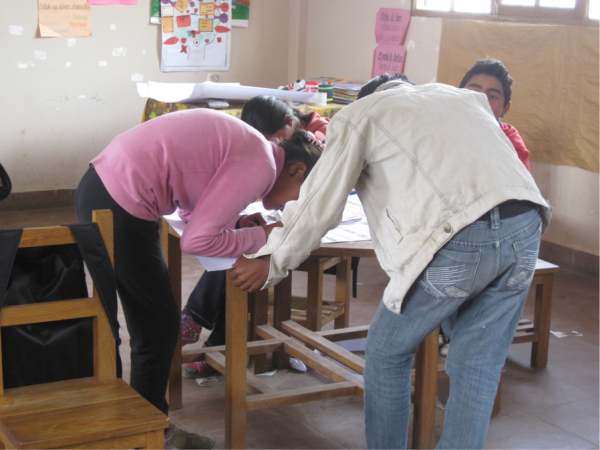Bilingual Education in Morado K’asa
- Posted In : morado-kasa , Stories , Children, education, Quechua, Spanish, Volunteer in Bolivia, Volunteering
- 0 : comment
Hi, I’m Jennifer, from the US! I’m spending June and most of July running a Club de Lectura in the small town of Morado K’asa, Bolivia. In addition from my work in the library, I have had the opportunity to help out at the primary school in Morado K’asa, running an activity on valores (values) for the kids in sixth grade.
As a very small town, Morado K’asa doesn’t have a high school––the teenagers attend school in a larger town a few miles away. It does, however, have a primary school, which is situated on a hill overlooking the town. All the kids from Morado attend the school. At the school, the kids get breakfast––a piece of bread and some kind of hot drink, usually api made of corn–and lunch, some form of rice and potatoes. Each class has about 12-15 students—and most faces are familiar from the library!
In addition to the uniquely Bolivian meals, the very voices of the students echo the reality of Morado K’asa. Like many schools on the Bolivian countryside, Morado K’asa’s primary school is bilingual, promoting both Spanish and the first language of the children of the town, Quechua. Quechua, a language drastically different grammatically from Spanish except for a few words it has adopted from the European language, is the language that the children speak playing with each other during el recreo, eating lunch, and doing chores.
Unlike most bilingual schools I am familiar with, Quechua and Spanish do not receive distinct spaces in the daily activities of Morado K’asa’s primary school. The teachers generally speak to the children in Spanish, and the children when left to themselves speak to each other in Quechua. Our activity with the kids from sexto (equivalent to the US sixth grade) was a fascinating demonstration of how the kids juggle and harmonize Spanish and Quechua in their educational lives as well as their lives outside of school.
In order to teach the kids the values of honestidad, responsabilidad, y respeto (honesty, responsibility, and respect), the teacher and I divided the class into groups that defined and analyzed the values. The spoke to each other in Spanish, and then, on large postboards, they outlined examples in Spanish. Afterward, they presented their projects. As before, the kids showed that they understood what they learned in both languages, naturally and without the prompting of the teacher.
Afterward, they presented their projects. As before, the kids showed that they understood what they learned in both languages, naturally and without the prompting of the teacher.
They read their examples in Spanish, and then turned to their classmates and explained the examples in Quechua. The teacher would then comment on their work in Spanish.
 The kids’ bilingualism is just another example of their potential to grow and to learn. While the books in the library are overwhelmingly in Spanish (with a few bilingual books in Quechua and Spanish), they don’t discourage the use of the kids’ first language. From their experience at school, the kids seem perfectly comfortable reading aloud to each other in Spanish, then laughing and discussing the illustrations or text in Quechua.
The kids’ bilingualism is just another example of their potential to grow and to learn. While the books in the library are overwhelmingly in Spanish (with a few bilingual books in Quechua and Spanish), they don’t discourage the use of the kids’ first language. From their experience at school, the kids seem perfectly comfortable reading aloud to each other in Spanish, then laughing and discussing the illustrations or text in Quechua.
Don’t worry—if you come to Morado K’asa, you will be able to communicate with the kids in Spanish! As I’m struggling to speak and understand Quechua, however, I’ve realized that understanding both of the kids’ languages lends an additional, special perspective. After all, they live and learn in a bilingual world—a world they’re proud of!

